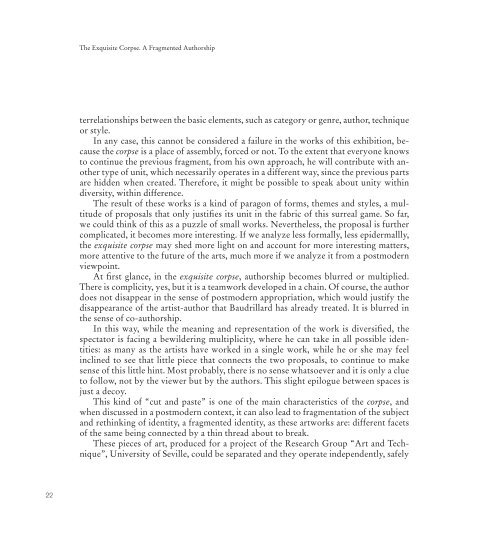un cadáver frente a mí - Universidad de Sevilla
un cadáver frente a mí - Universidad de Sevilla
un cadáver frente a mí - Universidad de Sevilla
Create successful ePaper yourself
Turn your PDF publications into a flip-book with our unique Google optimized e-Paper software.
22<br />
The Exquisite Corpse. A Fragmented Authorship<br />
terrelationships between the basic elements, such as category or genre, author, technique<br />
or style.<br />
In any case, this cannot be consi<strong>de</strong>red a failure in the works of this exhibition, because<br />
the corpse is a place of assembly, forced or not. To the extent that everyone knows<br />
to continue the previous fragment, from his own approach, he will contribute with another<br />
type of <strong>un</strong>it, which necessarily operates in a different way, since the previous parts<br />
are hid<strong>de</strong>n when created. Therefore, it might be possible to speak about <strong>un</strong>ity within<br />
diversity, within difference.<br />
The result of these works is a kind of paragon of forms, themes and styles, a multitu<strong>de</strong><br />
of proposals that only justifi es its <strong>un</strong>it in the fabric of this surreal game. So far,<br />
we could think of this as a puzzle of small works. Nevertheless, the proposal is further<br />
complicated, it becomes more interesting. If we analyze less formally, less epi<strong>de</strong>rmallly,<br />
the exquisite corpse may shed more light on and acco<strong>un</strong>t for more interesting matters,<br />
more attentive to the future of the arts, much more if we analyze it from a postmo<strong>de</strong>rn<br />
viewpoint.<br />
At fi rst glance, in the exquisite corpse, authorship becomes blurred or multiplied.<br />
There is complicity, yes, but it is a teamwork <strong>de</strong>veloped in a chain. Of course, the author<br />
does not disappear in the sense of postmo<strong>de</strong>rn appropriation, which would justify the<br />
disappearance of the artist-author that Baudrillard has already treated. It is blurred in<br />
the sense of co-authorship.<br />
In this way, while the meaning and representation of the work is diversifi ed, the<br />
spectator is facing a bewil<strong>de</strong>ring multiplicity, where he can take in all possible i<strong>de</strong>ntities:<br />
as many as the artists have worked in a single work, while he or she may feel<br />
inclined to see that little piece that connects the two proposals, to continue to make<br />
sense of this little hint. Most probably, there is no sense whatsoever and it is only a clue<br />
to follow, not by the viewer but by the authors. This slight epilogue between spaces is<br />
just a <strong>de</strong>coy.<br />
This kind of “cut and paste” is one of the main characteristics of the corpse, and<br />
when discussed in a postmo<strong>de</strong>rn context, it can also lead to fragmentation of the subject<br />
and rethinking of i<strong>de</strong>ntity, a fragmented i<strong>de</strong>ntity, as these artworks are: different facets<br />
of the same being connected by a thin thread about to break.<br />
These pieces of art, produced for a project of the Research Group “Art and Technique”,<br />
University of Seville, could be separated and they operate in<strong>de</strong>pen<strong>de</strong>ntly, safely



